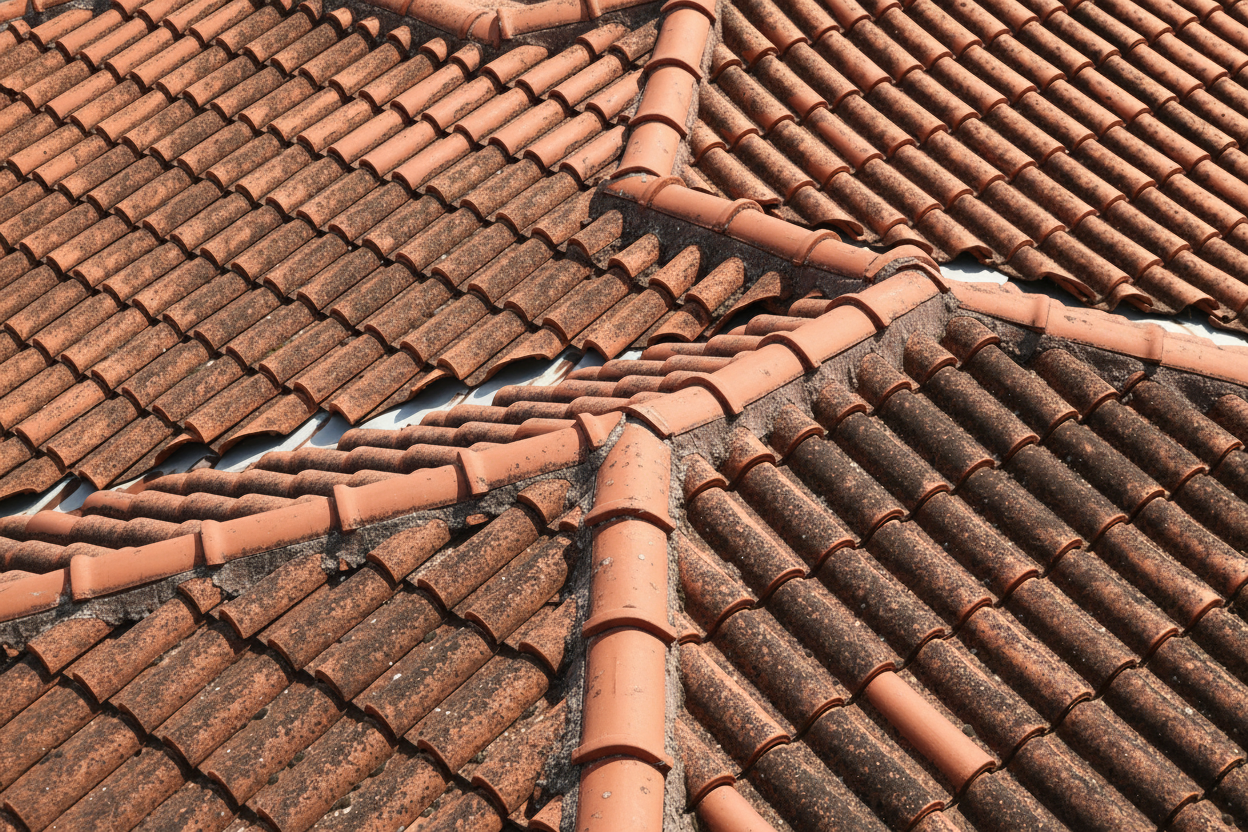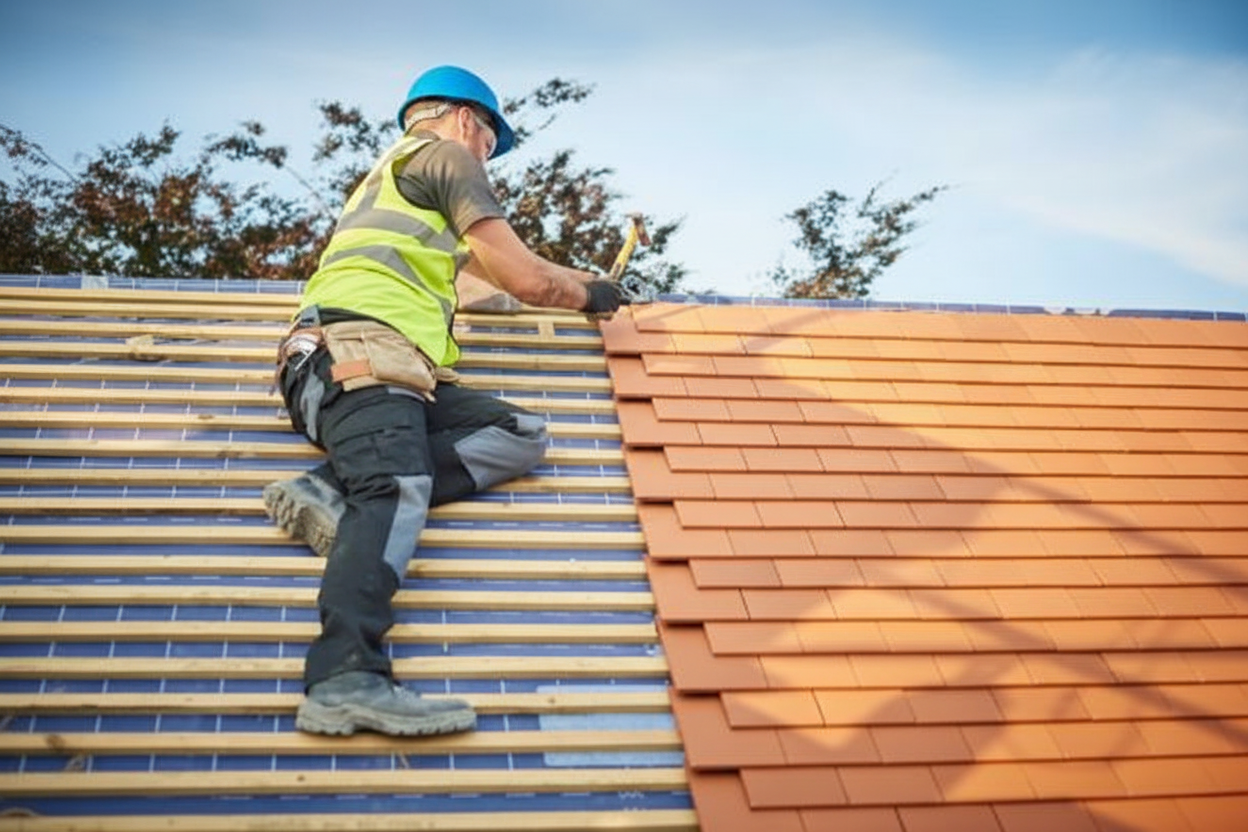
5 Types of Tile Roofs for Your Home in 2025
Maintenance & Repair
Tile Roofing Installation
October 30,2025
5 Types of Tile Roofs for Your Home in 2025

Alt text: Homeowners and roofing professionals examining different types of tile roofs on residential properties, showing variety of materials and styles
Choosing the right roof is one of the most important decisions you will make as a homeowner. Tile roofs stand out for their exceptional durability, energy efficiency, and timeless appeal. Whether you are building a new home or replacing an existing roof, understanding your options helps you make a confident choice.
Tile roofs can last 50 to 100 years or more, making them one of the most cost-effective roofing investments over time.
This guide walks you through five popular tile roof types. You will learn about their unique benefits, maintenance needs, and aesthetic qualities so you can find the perfect match for your home.
Clay tile roofs bring timeless elegance
Clay tiles have been protecting homes for centuries. Their warm, natural tones and classic profiles create a Mediterranean or Spanish-style look that never goes out of fashion.
What makes clay tiles special
Clay tiles are fired at high temperatures, making them incredibly durable. They resist fire, withstand harsh weather, and can last over 100 years with proper care. Their natural thermal properties help keep your home cooler in summer and warmer in winter, which can reduce your energy costs significantly.
You will find clay tiles in several profiles, including S-shaped and flat designs. The color palette ranges from classic terracotta to deep reds and earth tones. Many homeowners appreciate that terracotta tile roofs develop a beautiful patina over time.
Maintenance and care
Clay tiles need minimal upkeep. Plan for periodic inspections to check for cracked or displaced tiles. Remove debris from valleys and gutters to prevent water backup. Learn how to walk on tile roofs safely to avoid damage during maintenance.
Concrete tiles offer versatile style options
Concrete tiles give you design flexibility without sacrificing durability. Modern manufacturing techniques allow concrete tiles to mimic the appearance of clay, slate, or even wood shakes.
Why homeowners choose concrete
Concrete tiles deliver excellent value. They typically last 50 years or more and cost less than clay or slate. You can choose from dozens of colors and textures to match your home’s architecture. The material resists fire, rot, and insect damage.
Concrete tiles weigh less than clay but still provide excellent wind resistance, making them suitable for areas prone to storms.
Like clay, concrete tiles help regulate indoor temperature. This energy efficiency translates to lower utility bills throughout the year. When comparing clay vs concrete roof tiles, consider your budget and aesthetic preferences.
Long-term performance
Concrete tiles need occasional cleaning to remove moss or algae, especially in humid climates. Follow proven tile roof cleaning methods to maintain their appearance. Inspect your roof annually and address any signs of needed repair promptly.
Slate tiles deliver unmatched longevity
Slate represents the premium end of tile roofing. This natural stone creates a sophisticated look while providing protection that can exceed 100 years.
The slate advantage
Slate tiles come from quarried stone, giving each piece unique color variations. You will find shades of gray, green, purple, and black. The material is completely fireproof and highly resistant to moisture and freeze-thaw cycles.
The natural insulating properties of slate help maintain comfortable indoor temperatures. However, slate is heavy and requires a robust roof structure. Verify that your home can support the weight before choosing slate.

Alt text: Professional roofing contractors installing clay or concrete tiles on a residential roof, demonstrating proper installation techniques
Installation considerations
Slate requires specialized tile roof installation expertise. Work with experienced contractors who understand proper techniques. While slate needs little maintenance, damaged tiles should be replaced by professionals to preserve the roof’s integrity.
Comparing tile roof options
| Tile Type | Lifespan | Best For | Maintenance Level |
|---|---|---|---|
| Clay | 100+ years | Traditional homes | Low |
| Concrete | 50+ years | Budget-conscious buyers | Low to moderate |
| Slate | 100+ years | Premium applications | Low |
| Composite | 50+ years | Modern designs | Low |
| Metal | 40-70 years | Contemporary styles | Low |
Composite and metal tile alternatives
Composite tiles blend innovation with tradition
Composite roof tiles combine recycled materials with advanced polymers. They replicate the look of traditional materials while offering lighter weight and easier installation. Most composite tiles last 50 years and resist impact damage better than natural materials.
Metal tiles suit modern aesthetics
Metal tile roofs bring a sleek, contemporary appearance. They excel in durability and can last 40 to 70 years. Reflective coatings help reduce cooling costs by deflecting solar heat. Metal tiles resist fire, mildew, and rot while requiring minimal maintenance.
Understanding factors that affect tile roof lifespan helps you maximize your investment and plan for long-term care.
Making your tile roof choice
The right tile roof depends on your home’s architecture, your budget, and your local climate. Clay and slate offer unmatched longevity and classic beauty. Concrete provides excellent value with design versatility. Composite and metal tiles bring modern benefits at competitive prices.
Consider these factors when deciding:
- Your home’s structural capacity to support tile weight
- Local weather patterns and wind loads
- Your aesthetic preferences and neighborhood character
- Long-term maintenance commitment
- Budget for initial installation and lifecycle costs
When you are ready to move forward, working with experienced professionals ensures proper installation and maximizes your roof’s performance. Learn about when to consider tile roof replacement to time your project right.
